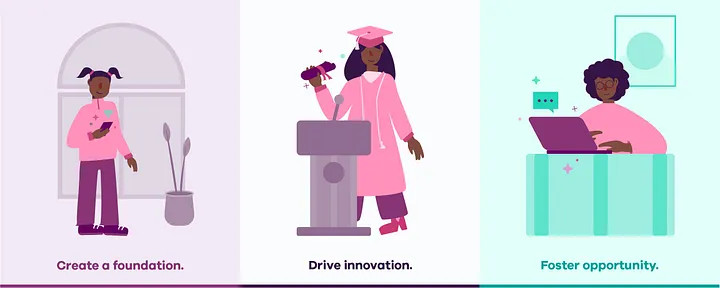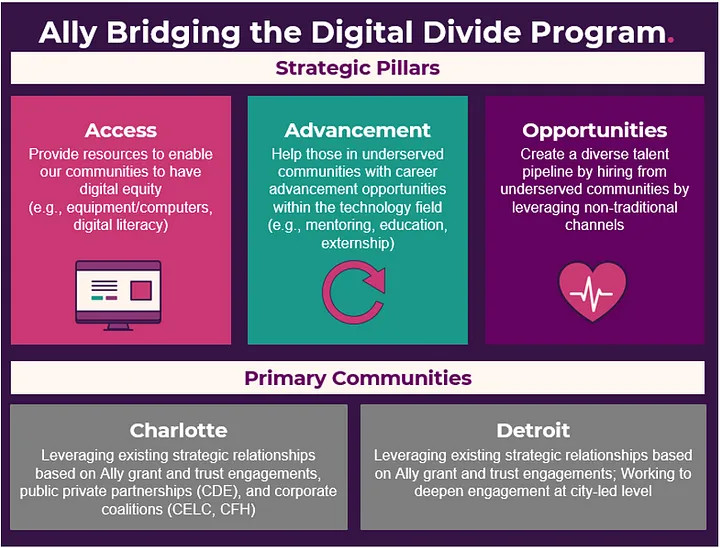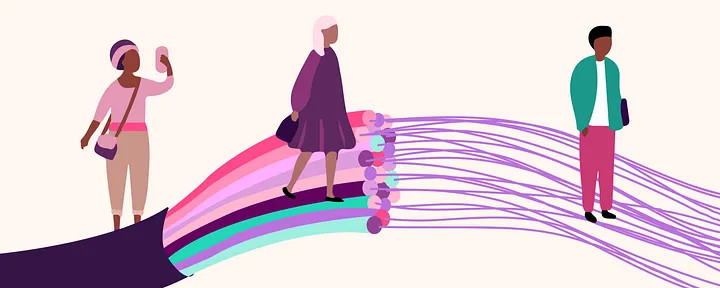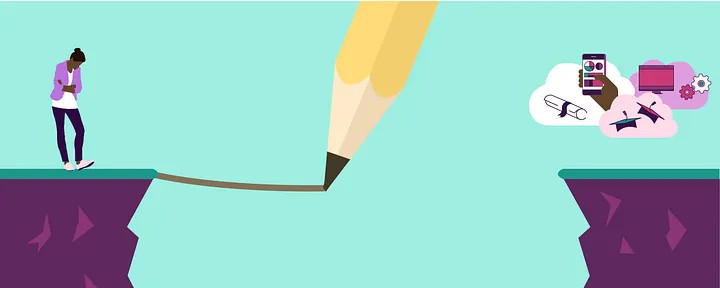Bridging the Digital Divide: Driving Towards Digital Equity & Inclusion for All
- 9 min read
Digital access is a basic need. Like food, housing, clothing, and electricity — digital access has become a fundamental requirement to function and prosper in society. Ensuring everyone has the opportunity and support to access and leverage digital capabilities is a matter of equity. Understanding that we can only combat this inequity by partnering together, this post focuses on providing key information, resources, and a high-level methodology to help individuals as well as organizations close the digital divide.
Defining Digital Divide
Gartner defines Digital Divide as “[t[he gap in opportunities experienced by those with limited accessibility to technology, especially the Internet. This includes, but is not limited to, accessibility challenges in the following areas:
Cultural (e.g., membership of a community that prohibits or restricts access to technology)
Physical (e.g., having a disability that make it difficult or impossible to use a computer)
Economic (e.g., being unable to afford a computer)
Educational (e.g., not knowing how to use a computer)”
In addition to the above, we would add not having access to reliable, high-speed internet. Although the depth and impact of a lack of access varies across demographic groups and location, its reality has ripple effects on individuals, communities, and our broader society.
Impacts of Digital Divide
On a larger scale, the digital divide reinforces racial inequity. According to the Harvard Business Review, nearly half of Americans without at-home internet are in Black and Hispanic households.
More specifically, according to Tufts University’s Digital Planet initiative, “[u]nlike the redlining of the past, digital redlining is not based explicitly on race, but rather on calculations of whether investing in building out high-speed internet will be supported by the demand in an area. Investing in fiber is expensive, and ISPs [internet service providers] tend to invest first in wealthier neighborhoods, while leaving poorer communities either without access or with slower legacy systems. Yet, poorer communities still pay the same for subpar service. Multiple studies show that areas on the wrong side of the digital divide are the same areas that were redlined in past.”
At the height of the COVID-19 pandemic, the digital gap became even more apparent.
Navigating the Pandemic: 90% of Americans said the internet was essential in navigating the pandemic. However, the average rate of broadband availability per county in the US is 76%. (Pew Research)
Education Access: As more than 55 million students moved to online learning during the pandemic, 1 in 5 teens, aged 13 to 17, reported being unable to do their homework “often” or “sometimes” because of unreliable internet access. While the challenges varied by location, 12 million children were without internet access altogether. (Harvard Business Review)
Healthcare Access: As the pandemic began, only 43% of health care centers could provide telemedicine. This reality meant many Americans were unable to access a crucial lifeline, particularly those with chronic and other health conditions. (Brookings)
Currently, a gap exists between those in urban and rural areas; between the educated and uneducated; between socioeconomic groups; and, globally, between the more and less industrially developed countries. The digital divide diminishes quality of life, economic opportunity, and social interaction for those without access.
Bridging the Digital Divide — Ally’s Approach and Impact (so far)

At Ally, we firmly believe it’s our social responsibility as corporate citizens to make a positive social impact on the world around us. This belief is embedded in the very fabric of our business and culture. We understand that digital inclusion raises people, and ultimately broader communities, up. That’s why we’re intentionally focusing on supporting and partnering with organizations that focus on addressing this gap through activities such as — hiring, equipment donations, digital and financial literacy, mentoring, and more.
With digital and financial equity as our central mission — Ally has built an operating model that has proven both manageable and impactful through a program we call Bridging the Digital Divide (BDD). Outlined below is how we approach the BDD program.

How we started (2021):
Focus — Ally’s BDD program ramped up, developing the program framework internally and engaging and aligning partners externally.
Access — We donated 2,250 refurbished desktop computers and laptops to various organizations including Detroit-based Human-i-T, Charlotte-based E2D and Road to Hire as well as Philadelphia-based Northern Children Services.
Advancement — We partnered with Goodwill Industries of the Southern Piedmont’s Goodwill University to offer a winter work-based learning opportunity to 16 graduates of its IT training program
Opportunities — We brought in a combined 18 new hires to Ally via the Road to Hire (R2H) apprenticeship program and the Carolina Fintech Hub (CFH) Career Technology Apprenticeship Cohort (CTAC). These Charlotte-based organizations focus on providing pathways to high growth careers in STEM (science, technology engineering, mathematics) for underrepresented populations.
Spotlight — Ally Charitable Foundation — Ally was among various partners to support the city of Charlotte Mayor’s Equity Initiative, a private-public partnership to address racial equity and provide new opportunities. Ally provided a $5 million commitment — a $2 million grant to support the Digital Divide and another $3 million to support the debt and equity needs of small businesses in the Corridors of Opportunity. In addition, we’ve expanded our community commitment by committing to hire interns and provide permanent job placements each year from Charlotte-based HBCU, John C. Smith University
How it’s going (2022):
Focus — Ally’s BDD program developed a more robust operating model and expanded our focus and impact on the community. We continue to use our key strategic pillars to guide our efforts with our ultimate program ‘North Star’ being to positively impact lives through equipment donations, unique engagements and hiring.
Access — To date, close to 3,000 refurbished laptops and desktops have been distributed to our communities by way of partnerships with Detroit-based Human-i-T and Charlotte-based E2D organizations.
Advancement — Ally employees’ giving back efforts power so much of the Ally BDD program efforts. In fact, that volunteerism is evident in a second time partnering with Goodwill University (U) through their summer Work-Based Learning Opportunity (WBLO) with 22 IT Training program students, average age of 41. Goodwill U participants noted that they gained an opportunity to work with employer partners, like Ally, on projects that provide hands-on learning and access to valuable industry connections.
Opportunities — This year, Ally will hire a combined 33 new hires from both the Road to Hire (R2H) apprenticeship program and Carolina Fintech Hub (CHS) Career Technology Apprenticeship Cohort (CTAC).
Spotlight — Code to Success Bootcamp — This year, we teamed up with the Code to Success summer coding bootcamp for high school students, administered by Charlotte’s Dottie Rose Foundation and Detroit’s Journi non-profit organization. We leveraged our Technically Speaking program, powered by the Ally Tech Academy, where we connect aspiring technologists, such as the Code to Success students, with Ally technology professionals to learn from their journey and broaden their skill sets. A few of the topics we covered with the students were ‘Various Roles in Tech’ and ‘The Power of Data.’ Attendance included 45 to 50 people, per session, including the 29 coding boot campers and an extended youth audience from Journi’s other programs.
To summarize, the first eight months of this year, we’ve clocked over 250 human hours in giving back and impacted close to 1,500 lives!
To successfully deliver, we operate based on the following key tenants –
Use a lean cross-functional operating model — Build and leverage key internal partnerships to effectively identify and scale initiatives. Ally’s model maintains a lean structure — Technology, Corporate Citizenship, and Human Resources, with the Technology organization serving as the lead — coordinating and facilitating initiatives. Furthermore, we operate under the umbrella of our Diversity, Equity, and Inclusion (DEI) strategy to ensure we keep those fundamentals front and center.
Leverage a coalition of external partnerships — Engage, partner, and deliver alongside strategic public, private, and non-profit partnerships. Ally’s primary focus is within our largest corporate centers — Charlotte and Detroit. While we do evaluate opportunities outside of these cities, we feel it’s important to work in partnership to improve the communities where we actively live and work.
Align volunteerism — Nearly every initiative requires volunteerism. Giving back is at the heart of Ally’s corporate identity, and our BDD program aims to leverage existing benefits (volunteer time off) as well as individual passion and skillsets to engage and activate employees. Ally is building a skilled-volunteerism database to quickly match an initiative to an interested and effective volunteer, streamlining the engagement process and maximizing the impact.
Continuously measure and refine — Identify the most impactful measurement of success. At Ally, we’re acutely focused on “lives impacted”. This is determined by a combination of factors based on the output across our strategic pillars. We continuously assess our impact, which helps us determine when and where to pivot to ensure we’re continuing to support initiatives that are making the biggest impact.
This is one model of how to organize resources to address digital and financial equity. The following section has additional resources for individuals to potentially improve their current situation as well organizations to use as reference points for how to further engage and develop their programs.
Available Resources
To learn more about all that is available to you and your community, select the listed links below.
A. Individual Resources
Get Internet— Through the Affordable Connectivity Program (ACP), eligible households receive $30 per month off their internet bill as well as a one-time discount of up to $100 to purchase a laptop, desktop computer, or tablet from participating providers. See if you qualify today!
B. Organization Resources (Community-based models)
Center for Digital Equity (CDE) — The Center for Digital Equity is an evolution of two key community initiatives; Digital Charlotte and the Charlotte Digital Inclusion Alliance and is housed at Queens University of Charlotte. Their mission is to make Mecklenburg County the most digitally equitable community in America.
Connect 313 — CONNECT 313 is a citywide, data-driven digital inclusion strategy that brings countless organizations together with the bold goal to make Detroit a national model for digital inclusion and ensure all Detroiters can access the digital world and the opportunity it brings. Their mission is to put in place by 2024 the means for all Detroiters to have access to appropriate devices, internet connections, technical support and digital resources for improved learning, employment, and wellbeing.
Eliminate the Digital Divide(E2D) — Since 2013, the E2D non-profit organization has worked with 167 schools in the Charlotte Mecklenburg School (CMS) system. As of Summer 2022, more than 30,000 families have bridged the digital divide using laptops provided by E2D. Their core programs are IT Workforce Development, Device Access, and Digital Inclusion/Broadband Access.
Human-i-t — Based in Detroit, Human i-t creates equitable access to opportunity by providing devices, internet access, digital skills training, and tech support for communities left on the wrong side of the digital divide — while at the same time, empowering businesses, and organizations to do good by diverting technology from landfills to protect our planet. They provide low-cost devices and internet, digital training, and tech support.
Ally Social Impact-Grants & Sponsorships — Ally believes everyone deserves a path to financial stability, security, and growth. We are committed to reducing barriers to economic mobility and fostering financial and social inclusion through our grants and sponsorships. Check out Ally’s 2021 Corporate Social Responsibility (CSR) report to learn more about their impact and Ally’s broader program.
Looking Ahead

Driving towards digital equity and inclusion for all in the ever-evolving world of technology presents its fair share of challenges. Yet, together as a community, we can significantly make an impact in closing the gap where we live, work and play. Recognizing there is a problem is half the battle. From there, we must work together — develop partnerships, understand community needs, create plans, implement solutions, and continuously learn. We know for certain technology will continue to change and evolve and we must put in the work now to build the networks and models that will be able to pivot and scale along with it.
Implementing the right or best strategies and tactics to bridge the digital divide may seem like a huge undertaking, but it’s all in your perspective. How do you eat an elephant? One bite at a time. This is not a sprint, it’s a marathon. We encourage readers to spread the available resources outlined within to your networks, leverage them yourselves, and partner with us on the journey.
We’re happy to share our learnings and collaborate on opportunities to make a community impact. Click here to get in touch.
Interested in joining Ally's team of talented technologists to make a difference for our customers and communities? Check outAlly Careersto learn more.